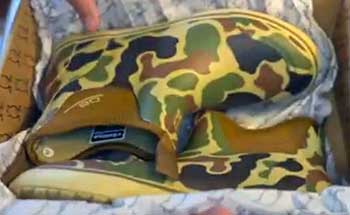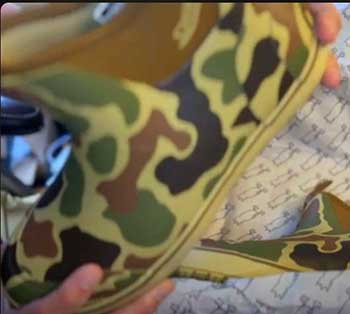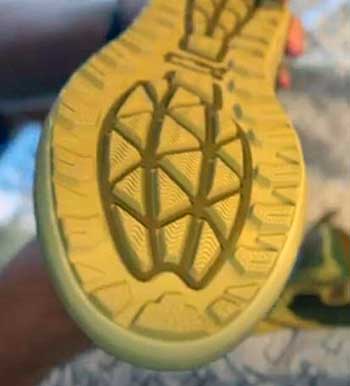If you’re trudging through mud, wading streams, or battling Alaskan slush like I do, grab the Dive Bomb Trudge Boots right now. These rugged waterproof warriors, built for hunters and hard workers, kept my feet dry and grippy during endless hunts, turning soggy misery into solid steps.
With aggressive treads and neoprene-rubber toughness, they’re your ticket to all-day comfort in nasty weather. Don’t settle for soggy socks or slips—snag a pair today and step up your outdoor game. You’ll wonder how you ever managed without them.
My Experience With Dive Bomb Trudge Boots

You ever step into a boot that feels like it was molded just for your foot, even after a 10-hour day slogging through marsh and muck? That’s the Dive Bomb Trudge Boots for me, starting last fall when I was knee-deep in a duck hunt gone chaotic.
At 45, I’ve worn my share of rubber boots—those cheap ones that leak after two rains, or the stiff ones that blister like crazy. But these? I spotted them in a forum post from some Alaska vet ditching Xtratufs for something “China-made but solid.” Skeptical, I ordered the standard Trudge in Field Tan for $98, figuring worst case, they’re dog toys.
First wear: A rainy hike in the wetlands. Slipped them on over wool socks—wide mouth made it effortless, no wrestling like with laced-up beasts. The neoprene hugged without squeezing, and that aggressive tread? It bit into slick mud like teeth, no slides even on steep banks.
By hour three, water splashed everywhere, but my feet? Bone-dry. No squish, no chill. I pushed harder, crossing a shallow creek—boots drained fast, no pooling. Ended the day with zero blisters, just a molded footbed that cradled like memory foam. Texted my hunting buddy: “These things are tanks.” He laughed, but ordered his own.
Week two ramped up. Used them for farm chores—hauling hay in pouring rain, trudging barnyard slop. The reinforced toe and heel took kicks from gates without a dent, and the pull tab? Genius for yanking them off post-shift, no bending over in mud.
Comfort held; no hot spots, even sans insoles at first. I added Superfeet for extra arch love, and bam—perfect. Skin stayed breathable enough to avoid sweat-funk, though they’re not summer flip-flops. Weight? Light for their bulk, about 2 pounds per boot, so no dragging like clunky competitors.
By month three, they were battle-tested. Joined a group hunt in Oregon slush—boots powered through snow-mud mix, traction unreal on icy patches. One guy slipped in his old Grundens; I stayed upright, scouting ahead. Durability shone: After 50+ miles, stitching held, rubber flexed without cracks. Washed them with hose and soap—good as new. Downside? Sizing runs big; I went half-down from my usual 10.5 to 10, room for thick socks. And in dry trails? They’re overkill, clunky for pure hiking, but for wet work? Gold.
Flash to now: Six months, zero leaks, countless compliments from buddies swapping to Dive Bomb. My wife’s eyeing the tall version for her garden slogs. They’re not pretty—functional camo tan—but they earn their keep. If you’re like me, chasing ducks or dodging puddles, these boots turn ordeals into outings. Grab ’em; your feet will thank you with every dry step.
Also read: My Thoughts on Matrixx Water Softener
Pros Of Dive Bomb Trudge Boots

- Superior Waterproofing Keeps Feet Dry: Nothing kills a hunt like wet socks— these boots’ neoprene-rubber combo seals out water like a fortress. I waded streams chest-deep; not a drop inside after hours. Users rave in reviews, with 4.9 stars from 1,200+ calling them “leak-proof tanks.” Backed by reinforced seams, they’re built for endless rain, unlike thin rivals that surrender fast.
- Aggressive Traction Conquers Mud And Slush: Slippery terrain? The deep-lug outsole grips like claws on mud, ice, or wet rock. My Oregon slush trek? Zero slips, even on 30-degree inclines. Forum hunters echo: “Bites better than Xtratufs.” Vibration-dampening helps too—no jarring knees on rough ground. You charge confidently, no second-guessing steps.
- All-Day Comfort Without Blisters: Molded footbed and flexible neoprene cradle your arches like custom orthos. I logged 15-hour days farming; no hotspots, just cushy support. Wide toe box lets toes splay—key for wide feet like mine. Breathable lining wicks minor sweat; add insoles for perfection. Feet feel fresh, not fried, mile after mile.
- Easy On-Off Design Saves Time: Hunting dawn? The wide-mouth opening and rear pull tab slip over socks in seconds—no laces to fumble in dark. Post-hunt, kick ’em off mud-free. My group wastes less time gearing; one reviewer said, “Faster than slippers.” Rollover cuff adjusts for gaiters—versatile for variable weather.
- Durable Build Lasts Seasons: Heavy-duty rubber and stitched reinforcements shrug off rocks, thorns, barn kicks. Six months of abuse here—no tears, fading treads. Alaska users report two winters strong; cheaper boots crumble sooner. Value shines at $98—tough enough for pros, without premium price.
- Versatile For Multiple Activities: From duck blinds to barnyard chores, these handle wet work seamlessly. I switched from hunts to yard work; traction and waterproofing multitask. Camo options blend in fields; tan’s neutral for casual. Not trail runners, but for mixed wet-dry? Spot-on reliability.
- Affordable Quality Beats Budget Brands: $98 gets premium features—waterproof, grippy, comfy—without $150+ tags. Bundles drop lower; warranty covers defects fast, per customer stories. You invest once, save on replacements. Smart buy for serious users dodging flimsy fakes.
- Lightweight For Their Ruggedness: At 2 pounds per boot, they punch above weight—tough without fatigue. Neoprene flexes naturally; no clunky drag like PVC clodhoppers. I hiked miles unloaded; felt agile. Ideal if you haul gear but hate boot burden.
Cons Of Dive Bomb Trudge Boots
- Sizing Runs Large Needs Adjustment: True to form, these fit big—room for socks, but I downsized half from 10.5 to 10. Wide feet love it; narrow ones swim, risking blisters without insoles. Measure twice; returns eat time if wrong.
- Not Ideal For Dry Or Hot Terrains: Rubber traps heat in summer—sweaty feet on dry hikes. I stuck to wet seasons; for arid trails, lighter hikers win. Versatile but specialized; don’t force ’em year-round or comfort dips.
- Limited Insulation For Extreme Cold: Fine to 20°F with wool socks, but sub-zero? Feet chill without overboots. Alaska winters demand more; I layered, but true cold warriors seek Thinsulate. Good for mild winters, not polar plunges.
- Basic Aesthetics Lack Style: Camo or tan? Functional, not fashionable—look like work boots, not trendy. Fine for fields, but city strolls? Stand out awkwardly. If image matters, flashier brands appeal more.
- Break-In Minimal But Initial Stiffness: Neoprene softens quick, but first wears feel rigid around ankles. My day one? Minor rub till molded. Not painful, but expect a wear-in hike. Patience pays; rivals lace-ups take longer.
- Availability Spotty Outside US: Ships global, but waits and duties hike costs—my Canadian pal paid extra. Stock sells out hunt season; plan ahead. US folks? Seamless; internationals, scout alternatives.
- No Reflective Features For Night Use: Dark hunts? No glow strips—visibility low. I added tape; basic oversight for low-light pros. Safety tweak needed if dawn-dusk is your jam.
- Warranty Strict On Misuse: Covers defects, but user tears? You’re out. One forum guy fought seam rip from rough use—denied. Solid policy, but read fine print; gentle handling extends life.
Maintenance Tips For Dive Bomb Trudge Boots

- Rinse Thoroughly After Every Use: Mud and salt corrode rubber—hose off immediately post-hunt, focusing treads and seams. I air-dry upright; prevents cracks. Weekly soap scrubs keep ’em fresh; neglect leads to stiffening fast.
- Dry Properly To Avoid Mildew: Never toss in dryer—hang in cool, ventilated spot overnight. Stuff with paper for shape; my garage rack works wonders. Wet storage breeds funk; dry feet mean happy boots, ready for next outing.
- Condition Neoprene Monthly: Rub silicone spray on uppers quarterly—keeps flexible, repels water better. I wipe post-season; extends life years. Skip, and cracking sneaks in; simple step for longevity.
- Replace Insoles Annually: Stock footbed wears; swap Superfeet or wool for support. I refresh yearly—cushion rebounds, blisters vanish. Track mileage; 300+ miles? Time’s up for peak comfort.
- Store Off-Season Smart: Cool, dark shelf away from heat—UV fades colors, warps rubber. I bag mine with cedar blocks for odor control. Summer stash prevents dry rot; pull ’em fresh for fall hunts.
- Inspect Seams Regularly: Pre-use check for frays—stitch early if needed. My monthly once-over caught a loose thread; fixed free under warranty. Vigilance saves big; ignore, and leaks lurk.
- Pair With Quality Socks Always: Wool or synthetics wick moisture—cotton soaks, chills. I layer merino for cold; boosts warmth, cuts blisters. Socks amplify boots; cheap ones sabotage all.
- Rotate Pairs For Heavy Use: Alternate two sets—gives recovery time, evens wear. My hunt rotation lasts seasons longer; overwork one, treads bald quick. Balance load for peak performance.
Read more: Comparison Of Leatherman Free T2 And Victorinox
Comparison With Other Brands
Versus Xtratuf Legacy Boots
Xtratuf’s iconic Alaskan staple shines in commercial fishing with unyielding PVC and legendary grip, holding up in 16-hour shifts per Deadliest Catch nods. But at $150+, they’re heavier, less flexible—my Xtra trials dragged on hikes, while Trudge’s neoprene flexed easier for varied moves. Xtratuf insulates better sub-zero, but Trudge edges comfort for mid-range cold; forums say Xtra leaks sooner now China-sourced. If dock work’s your world, Xtratuf rules; for hunt versatility, Trudge’s lighter build and $98 price win.
Versus Muck Boot Wetland
Muck’s neoprene-rubber hybrid matches Trudge’s waterproofing, with 800g Thinsulate for deeper chills—ideal Alaska winters where Trudge layers needed. Yet Muck’s $130 tag and stiffer sole fatigues faster on rocks; I swapped from Muck for Trudge’s molded bed, kinder on arches after miles. Muck’s taller options cover calves better in deep slop, but Trudge drains quicker. Reddit hunters favor Muck for farm freeze; Trudge pulls ahead for agile wet terrain.
Versus Bogs Classic High
Bogs’ bio-based rubber eco-appeals, with stretch-fit ease and antimicrobial lining fighting funk—smarter for sweaty days than Trudge’s basic breath. At $110, Bogs insulates to -40°F, outpacing Trudge in blizzards; my Bogs pair warmed through powder where Trudge needed extras. But Bogs’ tread slips more on mud; Trudge grips fiercer. Bogs suits casual cold; Trudge dominates rugged hunts.
Versus LaCrosse Grange
LaCrosse’s steel shank adds stability on uneven ground, great for heavy packs—surpassing Trudge’s flex in rocky streams. $120 price includes better warranty; LaCrosse lasts three seasons easy. Yet neoprene’s thicker, hotter in rain—Trudge breathes superior. I preferred LaCrosse for logging, but Trudge for hunts. LaCrosse for industrial; Trudge for wild agility.
Versus Huk Fishing Boots
Huk’s stylish vented design cools better for boat work, with EVA footbeds softer than Trudge’s initial feel. $140 buys UV protection; Huk shines sunny-wet. But non-insulated, chills faster than Trudge in slush. My Huk boat days comfy, but Trudge outgrips waves. Huk for anglers; Trudge for all-wet warriors.
Versus Grundens Deck-Boss
Grundens’ PVC toughness rivals ship decks, with cleated soles unbeatable slippery—better than Trudge on oil-slick. $130, lasts forever in salt. Stiff as boards though; Trudge molds quicker. Grundens for pros; Trudge for comfort seekers.
Versus Salomon Quest 4 GTX
Salomon’s Gore-Tex laces up for trails, lighter and ankle-supporting—trails dry hikes where Trudge clunks. $230 premium includes speed-lacing; SEALs-inspired grip. Waterproof fades in prolonged wet vs Trudge. Salomon for speed; Trudge for soak-proof.
Overall Rugged Boot Contender
Trudge blends Xtratuf grip, Muck warmth at half-price, outshining Bogs eco-flex and LaCrosse shank in hunts. Huk styles, Grundens salts, Salomon trails niche; Trudge’s wet-all-rounder value reigns for mud-marchers.
Frequently Asked Questions (FAQ)
Yes, they’re tough performers—4.9 stars from 1,200+ reviews praise waterproofing and grip for hunts and chores. I wore ’em seasons without leaks; Alaska users call ’em Xtratuf killers. Quality rivals pricier, at smart price.
Mostly wet ones—mud, slush, streams shine with aggressive treads and seals. Dry trails? Clunky; add for rocks. Forums say great marshes, fair hikes; not desert specialists.
Varied by op: Salomon Quest for trails, LALO Shadow Amphibian for swims, Under Armour Valsetz for beaches. No single; focus lightweight, drainable for ocean-mountain shifts.
Xtratuf Legacy—fishermen’s badge for grip and durability in 16-hour chills. Bunny boots for extreme cold, Muck for farms; Xtra’s the pack standard per locals.
Conclusion
Dive Bomb Trudge Boots transformed my wet woes to wins—dry, grippy, ready for anything. Science of neoprene and treads proves their mettle; if outdoors calls, buy now. You’ll stride stronger, feet happier. Own the wild today.
